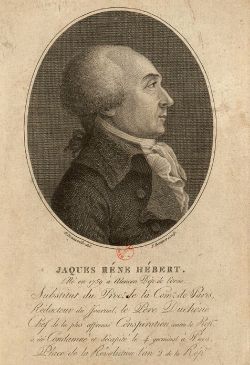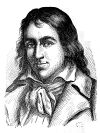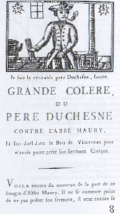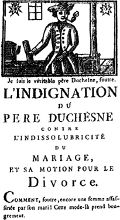Difference between revisions of "Jacques Hébert" - New World Encyclopedia
(first 100) |
(first 100) |
||
| Line 20: | Line 20: | ||
}} | }} | ||
| − | '''Jacques René Hébert''' ({{IPA-fr|ebɛʁ|lang}}; 15 November 1757 – 24 March 1794) was a French journalist and the founder and editor of the radical newspaper ''[[Le Père Duchesne]]'' during the [[French Revolution]]. He was sometimes called ''Père Duchesne'' due to the popularity of his newspaper and how closely he was identified with it. | + | '''Jacques René Hébert''' ({{IPA-fr|ebɛʁ|lang}}; 15 November 1757 – 24 March 1794) was a French journalist and the founder and editor of the radical newspaper ''[[Le Père Duchesne]]'' during the [[French Revolution]]. He was sometimes called ''Père Duchesne'' due to the popularity of his newspaper and how closely he was identified with it. Hébert was one of the key radical leaders of the French Revolution. His thousands of followers were known as ''the [[Hébertists]]'' (French ''Hébertistes''). He was one of the leaders of the [[Dechrisianization of France during the French Revolution|the dechristianization movement.]] |
| − | Hébert was | + | Hébert was known to be a genteel bourgeois whose newspaper was among the most radical and even scurrilous ones of the Revolution, going so far as to accuse the queen, [[Marie Antoinette]] of sexual relations with an African man. |
| + | |||
| + | Hébert was a member of the [[Cordeliers]] Club. He was considered to be a leader of the ''sans-culottes'' although he was not an urban worker himself. | ||
==Early life== | ==Early life== | ||
Revision as of 23:08, 8 August 2022
| Jacques Hébert | |

| |
| Born | 15 November 1757 Alençon, Kingdom of France |
|---|---|
| Died | 24 March 1794 (aged 36) Paris, French First Republic |
| Political party | The Mountain (1792–1794) |
| Spouse | ambox}} (m. 1792) |
| Children | Scipion-Virginia Hébert (1793–1830) |
| Residence | Paris, France |
| Occupation | Journalist, writer, publisher, politician |
| Signature | 
|
Jacques René Hébert (French pronunciation: [ebɛʁ]; 15 November 1757 – 24 March 1794) was a French journalist and the founder and editor of the radical newspaper Le Père Duchesne during the French Revolution. He was sometimes called Père Duchesne due to the popularity of his newspaper and how closely he was identified with it. Hébert was one of the key radical leaders of the French Revolution. His thousands of followers were known as the Hébertists (French Hébertistes). He was one of the leaders of the the dechristianization movement.
Hébert was known to be a genteel bourgeois whose newspaper was among the most radical and even scurrilous ones of the Revolution, going so far as to accuse the queen, Marie Antoinette of sexual relations with an African man.
Hébert was a member of the Cordeliers Club. He was considered to be a leader of the sans-culottes although he was not an urban worker himself.
Early life
Jacques René Hébert was born on November 15, 1757 in Alençon, to goldsmith, former trial judge, and deputy consul Jacques Hébert (died 1766) and Marguerite Beunaiche de Houdrie (1727–1787).
Hébert studied law at the College of Alençon and went into practice as a clerk to a solicitor of Alençon. He was ruined by a lawsuit against a Dr. Clouet. Hébert fled first to Rouen and then to Paris. For a while, he passed through a difficult financial time and lived through the support of a hairdresser in Rue des Noyers. There he found work in a theater, La République, where he wrote plays in his spare time, but they were never produced. Hébert was eventually fired for theft and entered the service of a doctor. It is alleged that he lived through expediency and scams.
In 1789, he began his writing with a pamphlet "la Lanterne magique ou le Fléau des Aristocrates" (Magic Lantern, or Scourge of Aristocrats). He published a few booklets. In 1790, he attracted attention through a pamphlet he published, and became a prominent member of the political club of the Cordeliers in 1791.
Père Duchesne
From 1790 until his death in 1794, Hébert became a voice for the sans-culottes of Paris through his highly successful and influential journal, Le Père Duchesne.[1] In his journal, Hébert assumed the voice of a patriotic sans-culotte named Père Duchesne and would write first-person narratives in which Père Duchesne would often relay fictitious conversations that he had with the French monarchs or government officials.[2] Hébert and the Hébertists often expressed the view that many more aristocrats should be examined, denounced, and executed, as they argued that Revolutionary France could only be fully reborn through the elimination of its ancient and supposedly currently malignant nobility.[3] In Le Père Duchesne number 65, in which he writes of his reawakening in 1790, he defines aristocrats as "enemies of the constitution" who "conspire against the nation."[4] Much of Hébert's celebrity came from his denunciations of King Louis XVI in his newspaper, as opposed to the government office he held or his roles in any of the Parisian clubs with which he was involved.[5]
These stories encouraged violent behaviors and utilized foul and sexualized language. Père Duchesne's stories were also witty, reflective, and resonated with the poorer Parisian quarters. Street hawkers would yell: Il est bougrement en colère aujourd’hui le père Duchesne! (Father Duchesne is very angry today!).[citation needed]
Although Hébert did not create the image of the Père Duchesne, his use of the character helped to transform the symbolic image of Père Duchesne from that of a comical stove-merchant into a role model for the sans-culottes.[6] Hébert used Père Duchesne as a revolutionary symbol, a bristly old man who was portrayed as smoking a pipe and wearing a Phrygian cap. He constantly felt great anger but also would experience great happiness. He was never afraid to fully display exactly how he was feeling. He would constantly use foul language and other harsh words to express himself.[7]
Because he reflected both his audience's speech and dressing style, his readers listened to and followed his message. The French linguist and historian Ferdinand Brunot called Hébert "The Homer of filth" because of his ability to use common language to appeal to general audiences.[8] In addition, Père Duchesne's appearance played into the tensions of the revolution through the sharp contrast of his clothing and portrayal as a laborer against the crown and aristocracy's formal attire.Cite error: Closing </ref> missing for <ref> tag Hébert was not the only writer during the French Revolution to use the image of Père Duchesne nor was he the only author in the period to adopt foul language as a way of appealing to the ''sans-culottes''. Another writer at the time, Lemaire, also wrote a newspaper entitled Père Duchêne (although he spelt it differently than Hébert) from September 1790 until May 1792 in which he assumed the voice of a "moderate patriot" who wanted to conserve the relationship between the King and the nation. Lemaire's character also used a slew of profanities and would address France's military. Hébert's paper, however, became far more popular. In part, this was due to the Paris Commune deciding to buy his papers and distribute them to the French military for distribution to soldiers in training. Starting in 1792 the Paris Commune and the ministers of war Jean-Nicolas Pache and, later, Jean Baptiste Noël Bouchotte bought several thousand copies of Le Père Duchesne which were distributed free to the public and troops. This happened again in May and June 1793 when the Minister of War bought copies of newspapers in order to "enlighten and animate their patriotism." It is estimated that Hébert received 205,000 livres from this purchase.[9] The death of Jean-Paul Marat on July 13, 1793, publisher of L'Ami du peuple, allowed Le Père Duchesne to become the incontestable best-selling paper in Paris, which also played into the number of copies bought during those months.[10]
Hébert's political commentary between 1790 and 1793 focused on the lavish excesses of the monarchy. Initially, from 1790 and into 1792, Le Père Duchesne supported a constitutional monarchy and was even favorable towards King Louis XVI and the opinions of the Marquis de La Fayette. His violent attacks of the period were aimed at Jean-Sifrein Maury, a great defender of papal authority and the main opponent of the Civil Constitution of the Clergy. Although the character of Père Duchesne supported a constitutional monarchy, he was always highly critical of Queen Marie Antoinette. Knowing that the queen was an easy target for ridicule after the Diamond Necklace Affair, she became a consistent target in the paper and a scapegoat for many of France's political problems. By identifying Marie Antoinette's lavish excesses and alleged sexuality as the core of the monarchy's problems, Hébert's articles suggested that, if Marie Antoinette would change her ways and renounce aristocratic excesses, then the monarchy could be saved and the queen could return to the good will of the people. Despite his view that the monarchy could be restored, Hébert was skeptical of the queen's willingness to do so and often characterized her as an evil enemy of the people by referring to Queen Marie Antoinette as "Madame Veto" and addressing King Louis XVI as "drunken and lazy; a cuckolded pig".[11] Initially, Hébert was trying to not only educate his readers about the Queen, but also awaken her to how she was viewed by the French public. Many of the conversations that Père Duchesne carries with her in the newspaper are attempts at either showcasing her supposed nymphomania or attempts to beg her to repent and reverse her wicked ways.[12] With the king's failed flight to Varennes his tone significantly hardened.
At the time, many writers and journalists were greatly influenced by the proclamation of martial law on October 21, 1789. It invoked various questions and patterns of Revolutionary thinking and inspired various forms of writing such as Le Père Duchesne. The law prompted multiple interpretations all of which led to what became essential Revolutionary ideals.[13]
Revolutionary role
Hébert agreed with most of the ideals of the radical Montagnard faction; however, he was not a member of the faction.
On July 17, 1791, Hébert was at the Champ de Mars to sign a petition to demand the removal of King Louis XVI and was caught up in the subsequent Champ de Mars massacre by troops under Lafayette. This put him in the revolutionary mindset, and the Le Père Duchesne adopted a sloppier style to better appeal to the masses. Le Père Duchesne began to attack Lafayette, Mirabeau, and Bailly. In a 1793 speech to the public, Hébert stated his beliefs regarding Lafayette. He noted that there were two Père Duchesnes who opposed each other deeply. The Père Duchesne that he said he identified with was the "honest and loyal Père Duchesne who has pursued traitors," while the Père Duchesne he had nothing to do with "praised Lafayette to the heavens."[14] Following Louis's failed flight to Varennes he began to attack both Louis and Pope Pius VI as well.
Hébert met his future wife Marie Goupil (born 1756), a 37-year-old former nun who had left convent life at the Sisters of Providence convent at rue Saint-Honoré. Marie's passport from this time shows regular use.[citation needed] They married on February 7, 1792, and had a daughter, Virginia Scipion-Hébert (February 7, 1793 – July 13, 1830). During this time, Hébert had a luxurious, bourgeois life. He entertained Jean-Nicolas Pache, the mayor of Paris and Minister of War, for weeks, as well as other influential men, and liked to dress elegantly and surround himself with beautiful objects such as pretty tapestries—an attitude that can be contrasted to that of Paris Commune president, Pierre Gaspard Chaumette. Where he got the financial resources to support his lifestyle is unclear, but Jean-Nicolas Pache had commissioned thousands of issues of Le Père Duchesne. Another possible source was his relationship to Delaunay d'Angers, mistress and wife of Andres Maria de Guzman.
As a member of Cordeliers club, he had a seat in the revolutionary Paris Commune where on Insurrection of 10 August 1792 he was sent to the Bonne-Nouvelle section of Paris. As a public journalist, he supported the September Massacres. On December 22, 1792, he was appointed the second substitute of the procureur of the commune, and until August 1793 he supported the attacks against the Girondin faction. In April–May 1793 he, along with Jean-Paul Marat and others, violently attacked the Girondins.
In February 1793, he voted with fellow bourgeois Hébertists against the Maximum Price Act, a price ceiling on grain, on the grounds it would cause hoarding and stir resentment. On May 20, 1793, the moderate majority of the National Convention formed the Special Commission of Twelve, which was designed to investigate and prosecute conspirators. At the urging of the Twelve on May 24, 1793, he was arrested.
However, Hébert had been warned in time, and, with the support of the sans-culottes, the National Convention was forced to order his release three days later.
Dechristianization
Dechristianization was an anti-clerical movement during the French Revolution. Advocates believed that to pursue a secular society, they had to reject the superstitions of the old regime and, as an extension, Catholicism. The trend toward secularization had already begun to take hold throughout France during the eighteenth century. Between September 1793 and August 1794, French politicians began discussing and embracing notions of "radical dechristianization."[15] While Robespierre advocated for the right to religion and believed that aggressively pursuing dechristianization would spur widespread revolts throughout rural France, Hébert and his followers, the Hébertists, wanted to spontaneously and violently overhaul religion.[16] The writer and philosopher Voltaire was an inspiration to Hébert on this front. Like Voltaire, Hébert believed that the toleration of different religious beliefs was necessary for humanity to pass from an age of superstition and that traditional religion was an obstacle to this goal. Eventually, Hébert would argue that Jesus was not a demigod, but instead a good sans-culotte. Voltaire had also provided him with the basic tenets of a civic religion that would be able to replace traditional religion.[17] The program of dechristianization waged against Catholicism, and eventually against all forms of Christianity, included the deportation of clergy and the condemnation of many of them to death, the closing of churches, the institution of revolutionary and civic cults, the large scale destruction of religious monuments, the outlawing of public and private worship and religious education, forced marriages of the clergy and forced abjurement of their priesthood. On October 21, 1793 a law was passed which made all suspected priests and all persons who harbored them liable to death on sight.[18]
On November 10, 1793, dechristianization reached what many historians consider the climax of the movement when the Hébertists moved the first celebration of the Festival of Reason, a civic festival celebrating the goddess of Reason, from the Circus of the Palais Royale to the Cathedral of Notre Dame and reclaimed the cathedral as a "Temple of Reason."[19] On 7 June Robespierre, who had previously condemned the Cult of Reason, advocated a new state religion and recommended that the Convention acknowledge the existence of God. On the next day, the worship of the deistic Supreme Being was inaugurated as an official aspect of the Revolution. Compared with Hébert's somewhat popular festivals, this austere new religion of Virtue was received with signs of hostility by the Parisian public.[citation needed]
Clash with Robespierre, arrest, conviction, and execution
After successfully attacking the Girondins, Hébert in fall of 1793 continued to attack those who he viewed as too moderate, including Danton, Philippeaux, and Robespierre, among others. When Hébert accused Marie-Antoinette during her trial of incest with her son, Robespierre called him a fool ("imbécile") for his outrageous and unsubstantiated innuendos and lies.[20]
The government, with support from the Jacobins, was exasperated and finally decided to strike on the night of March 13, 1794, despite the reluctance of Barère de Vieuzac, Collot d'Herbois and Billaud-Varenne. The order was to arrest the leaders of the Hébertists; these included individuals in the War Ministry and others.
In the Revolutionary Tribunal, Hébert was treated very differently from Danton, more like a thief than a conspirator. His earlier scams were brought to light and criticized. He was sentenced to death with his co-defendants on the third day of deliberations. Their execution by guillotine took place on March 24, 1794.[21] Hébert fainted several times on the way to the guillotine and screamed hysterically when he was placed under the blade. Hébert's executioners amused the crowd by adjusting the guillotine so that its blade stopped inches above his neck,[22] and it was only after the fourth time the lever (déclic) was pulled that he was actually beheaded. His corpse was disposed of in the Madeleine Cemetery. His widow was executed twenty days later on April 13, 1794, and her corpse was disposed of in the Errancis Cemetery.
The importance of Hébert's execution was known by everyone involved in the revolution, including the Jacobins. Saint-Just, a prominent Jacobin leader, noted that following his execution, "the revolution is frozen,"[23] demonstrating how central Hébert and his followers, the sans-culottes, were to the longevity and success of the revolution.
Influence
It is difficult to ascertain the extent to which Hébert's publication Le Père Duchesne impacted the outcomes of political events between 1790 and 1794. French revolutionary historians such as Jean-Paul Bertaud, Jeremy D. Popkin, and William J. Murray each investigated French Revolutionary press history and determined that while the newspapers and magazines that one read during the revolution may have influenced their political leanings, it did not necessarily create their political leanings. One's class, for example, could be a significant determinant in directing and influencing one's political decisions. Therefore, Hébert's writings certainly influenced his audience to often dramatic extent, but the sans-culottes were but one element in a complex political mix, meaning that it is difficult to determine in what ways his writing changed the political outcomes of the French Revolution.[24] His wide readership and voice throughout the Revolution means that he was a significant public figure and Le Père Duchesne's ability to influence the general population of France was indeed notable.
Gallery
Footnotes
- ↑ Doyle, William (1989); The Oxford History of the French Revolution; Clarendon Press; Template:ISBN. See p.227: "[Hébert] was himself a journalist... producer of the increasingly popular Père Duchesne."
- ↑ Sonenscher, Michael. "The Sans-culottes of the Year II: Rethinking the Language of Labour in Revolutionary France," Social History 9(3), 1984, 326.
- ↑ "Caroline Weber, Terror and Its Discontents: Suspect Words in Revolutionary France (Minneapolis, MN: University of Minnesota Press, 2003, ISBN 978-0816693337), 78
- ↑ Jacques-René Hébert, "The Reawakening of Père Duchesne," Père Duchesne, 1790, Retrieved July 31, 2022.
- ↑ Charles B. McNamara, THE HEBERTISTS: STUDY OF A FRENCH REVOLUTIONARY "FACTION" IN THE REIGN OF TERROR, 1793-1794 (New York, NY: Fordham University, 1974.
- ↑ Elizabeth Colwill, "Just Another 'Citoyenne?' Marie-Antoinette on Trial, 1790–1793," History Workshop 28(28), 1989, 65.
- ↑ Paul Beik, The French Revolution (New York, NY: Walker and Company Publishing ,1971, ISBN 978-0802720368), 271-276. chapter=November, 1793: Père Duchesne, His Plebeian Appeal}}
- ↑ John Thomas Gilchrist, Press in the French Revolution (New York, NY: St. Martin's Press, 1971, ISBN978-0602219222 ), 21.
- ↑ Gilchrist, 21.
- ↑ William Doyle, The Oxford History of the French Revolution (Oxford, UK: Clarendon Press, 1989, ISBN 0198227817), 250. "Hébert’s Père Duchesne, written in the oath-strewn vernacular, became the undisputed best-selling paper in Paris once Marat was silenced."
- ↑ Colwill, 72–73.
- ↑ Thomas Kaiser, "Who’s Afraid of Marie-Antoinette? Diplomacy, Austrophobia, and the Queen," French History 14(3), 2000, 241–271.
- ↑ Aurélie Neusy, "Opinions et réflexions sur la loi martiale dans la presse et les pamphlets (1789‑1792)," Annales Historiques de la Révolution Française, 360, April 1, 2011, 27–48.
- ↑ (2018) "Jacques Hébert", The Permanent Guillotine: Writings of the Sans-Culottes. Oakland, CA: PM Press, 98. ISBN 978-1-629-63406-7.
- ↑ Roger Chartier, The Cultural Origins of the French Revolution, trans. Lydia G. Cochrane, (Durham, NC: Duke University Press, 1991, ISBN 978-0822309819), 105–106
- ↑ Arno J. Mayer, The Furies: Violence and Terror in the French and Russian Revolutions (Princeton, NJ: Princeton University Press, 2000, ISBN 978-0691048970), 441–442.
- ↑ Charles A. Gliozzo, "The Philosophes and Religion: Intellectual Origins of the Dechristianization Movement in the French Revolution," Church History 40(3), Sept. 1971, 273–283.
- ↑ A. Latreille, "French Revolution," in New Catholic Encyclopedia 2nd. ed. volume 5, Thomson-Gale, 2003, ISBN 978-0787640040), 972–973.
- ↑ Arno, 441-442.
- ↑ Joachim Vilate (1795) Causes secrètes de la révolution du 9 au 10 thermidor, p. 12-13
- ↑ Doyle, 270. "The trial took place on 21–4 March, its result a foregone conclusion. Among those who went to the scaffold with Pere Duchesne on the afternoon of the twenty-fourth were Vincent, Ronsin, and the leader of section Marat, Momoro."
- ↑ Page 27 BBC History Magazine, September 2015
- ↑ (2018) "Introduction", The Permanent Guillotine:Writings of the Sans-Culottes. Oakland, CA:PM Press, 14. ISBN 978-1-629-63406-7.
- ↑ Jeremy D. Popkin, "The Press and the French Revolution after Two Hundred Years," French Historical Studies 16(3), 1990, 668–670.
ReferencesISBN links support NWE through referral fees
- Louis Duval, "Hébert chez lui", in La Révolution Française, revue d'histoire moderne et contemporaine, t. xii. and t. xiii.
- D. Mater, J. R. Hibert, L'auteur du Père Duchesne avant la journée du 10 août 1792 (Bourges, Comm. Hist. du Cher, 1888).
- François Victor Alphonse Aulard, Le Culte de la raison et de l'être suprême (Paris, 1892).
External links
Link retrieved July 31, 2022.
- Jacques Hébert Internet Archive on Marxists.org
Credits
New World Encyclopedia writers and editors rewrote and completed the Wikipedia article in accordance with New World Encyclopedia standards. This article abides by terms of the Creative Commons CC-by-sa 3.0 License (CC-by-sa), which may be used and disseminated with proper attribution. Credit is due under the terms of this license that can reference both the New World Encyclopedia contributors and the selfless volunteer contributors of the Wikimedia Foundation. To cite this article click here for a list of acceptable citing formats.The history of earlier contributions by wikipedians is accessible to researchers here:
The history of this article since it was imported to New World Encyclopedia:
Note: Some restrictions may apply to use of individual images which are separately licensed.




